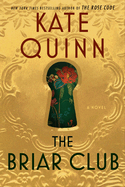
Historical novelist Kate Quinn (The Alice Network; The Huntress) stirs up a spicy, complex gumbo of female friendship, tricky gender politics, and McCarthy-era rhetoric in her taut, vivid novel The Briar Club. Quinn weaves together the narratives and secrets of a motley collection of neighbors in 1950s Washington, D.C., and draws back the (lace) curtains on their complicated lives.
Quinn begins her narrative in 1954, with a shocking double murder at the genteel boardinghouse, Briarwood House. She then flashes back four years to the arrival of Grace March, an elegant, enigmatic widow with a gift for throwing parties. As she settles into life at Briarwood House, Grace manages to charm nearly everyone, including prickly artist Reka, proper English mum Fliss, tough baseball slugger Bea, and Pete Nilsson, the landlady's lonely teenage son. Grace's Thursday night communal suppers quickly become legendary, and gradually, the residents of Briarwood House form deep bonds. But their lives--especially Grace's--all contain secrets too sensitive for public view amid rising Cold War tensions.
Through her characters, Quinn explores the racial, sexual, and ideological politics of post-World War II Washington, D.C., contrasting the residents' carefully constructed public images and the real lives behind them. The novel's twists will make readers gasp, but the cozy scenes in Grace's flat (with accompanying recipes) will leave them hankering to spend a Thursday evening with the ladies of Briarwood House. Like Grace's supper parties, The Briar Club provides a mix of zest, salt, and nourishing flavor: incisive social commentary; romance and heartbreak; ambition and professional obstacles; and a tribute to deep, unexpected friendship. --Katie Noah Gibson, blogger at Cakes, Tea and Dreams

